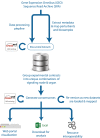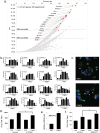The Signaling Pathways Project, an integrated 'omics knowledgebase for mammalian cellular signaling pathways
- PMID: 31672983
- PMCID: PMC6823428
- DOI: 10.1038/s41597-019-0193-4
The Signaling Pathways Project, an integrated 'omics knowledgebase for mammalian cellular signaling pathways
Abstract
Mining of integrated public transcriptomic and ChIP-Seq (cistromic) datasets can illuminate functions of mammalian cellular signaling pathways not yet explored in the research literature. Here, we designed a web knowledgebase, the Signaling Pathways Project (SPP), which incorporates community classifications of signaling pathway nodes (receptors, enzymes, transcription factors and co-nodes) and their cognate bioactive small molecules. We then mapped over 10,000 public transcriptomic or cistromic experiments to their pathway node or biosample of study. To enable prediction of pathway node-gene target transcriptional regulatory relationships through SPP, we generated consensus 'omics signatures, or consensomes, which ranked genes based on measures of their significant differential expression or promoter occupancy across transcriptomic or cistromic experiments mapped to a specific node family. Consensomes were validated using alignment with canonical literature knowledge, gene target-level integration of transcriptomic and cistromic data points, and in bench experiments confirming previously uncharacterized node-gene target regulatory relationships. To expose the SPP knowledgebase to researchers, a web browser interface was designed that accommodates numerous routine data mining strategies. SPP is freely accessible at https://www.signalingpathways.org .
Conflict of interest statement
Charles Foulds has equity in Coactigon, Inc.
Figures







Similar articles
-
No Dataset Left Behind: Mechanistic Insights into Thyroid Receptor Signaling Through Transcriptomic Consensome Meta-Analysis.Thyroid. 2020 Apr;30(4):621-639. doi: 10.1089/thy.2019.0307. Epub 2020 Jan 29. Thyroid. 2020. PMID: 31910096 Free PMC article.
-
Consensus transcriptional regulatory networks of coronavirus-infected human cells.bioRxiv [Preprint]. 2020 Jul 15:2020.04.24.059527. doi: 10.1101/2020.04.24.059527. bioRxiv. 2020. Update in: Sci Data. 2020 Sep 22;7(1):314. doi: 10.1038/s41597-020-00628-6. PMID: 32511379 Free PMC article. Updated. Preprint.
-
Signaling network of dendritic cells in response to pathogens: a community-input supported knowledgebase.BMC Syst Biol. 2010 Oct 7;4:137. doi: 10.1186/1752-0509-4-137. BMC Syst Biol. 2010. PMID: 20929569 Free PMC article.
-
Plant Reactome and PubChem: The Plant Pathway and (Bio)Chemical Entity Knowledgebases.Methods Mol Biol. 2022;2443:511-525. doi: 10.1007/978-1-0716-2067-0_27. Methods Mol Biol. 2022. PMID: 35037224 Review.
-
[From genome analysis to construction of an integrated omics knowledgebase for crops].Yi Chuan. 2019 Sep 20;41(9):875-882. doi: 10.16288/j.yczz.19-121. Yi Chuan. 2019. PMID: 31549685 Review. Chinese.
Cited by
-
MED19 encodes two unique protein isoforms that confer prostate cancer growth under low androgen through distinct gene expression programs.Sci Rep. 2023 Oct 25;13(1):18227. doi: 10.1038/s41598-023-45199-9. Sci Rep. 2023. PMID: 37880276 Free PMC article.
-
Cell type-specific potential pathogenic genes and functional pathways in Alzheimer's Disease.BMC Neurol. 2021 Oct 2;21(1):381. doi: 10.1186/s12883-021-02407-1. BMC Neurol. 2021. PMID: 34600516 Free PMC article.
-
Overlapping variants in the blood, tissues and cell lines for patients with intracranial meningiomas are predominant in stem cell-related genes.Heliyon. 2020 Nov 30;6(11):e05632. doi: 10.1016/j.heliyon.2020.e05632. eCollection 2020 Nov. Heliyon. 2020. PMID: 33305042 Free PMC article.
-
Islet single-cell transcriptomic profiling during obesity-induced beta cell expansion in female mice.iScience. 2025 Feb 15;28(3):112031. doi: 10.1016/j.isci.2025.112031. eCollection 2025 Mar 21. iScience. 2025. PMID: 40104055 Free PMC article.
-
CDC7 inhibition impairs neuroendocrine transformation in lung and prostate tumors through MYC degradation.Signal Transduct Target Ther. 2024 Jul 26;9(1):189. doi: 10.1038/s41392-024-01908-y. Signal Transduct Target Ther. 2024. PMID: 39054323 Free PMC article.
References
-
- Becnel Lauren B., Ochsner Scott A., Darlington Yolanda F., McOwiti Apollo, Kankanamge Wasula H., Dehart Michael, Naumov Alexey, McKenna Neil J. Discovering relationships between nuclear receptor signaling pathways, genes, and tissues in Transcriptomine. Science Signaling. 2017;10(476):eaah6275. doi: 10.1126/scisignal.aah6275. - DOI - PubMed
MeSH terms
Grants and funding
LinkOut - more resources
Full Text Sources
Miscellaneous

